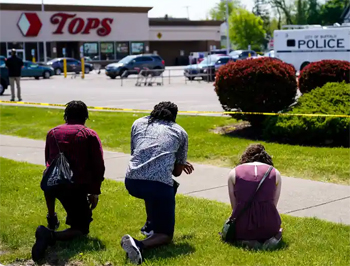Until recent times a rampage shooting was a rare event, but rampage shootings have been a part of world history for years. Rampage shootings occurred infrequently in the United States until eight occurred in the 1980s. Some were especially lethal such as the 1984 rampage in a McDonald’s, which resulted in 22 people killed and 19 injured. In 1986 a postal employee killed 15 people and injured six people, introducing “going postal” into the vernacular. Since that time the United States has been the epicenter of rampage shootings.
Rampage shootings escalated in the 1990s, becoming part of a mean-spirited cultural landscape of the United States . This dramatic and unprecedented surge in rampage school shootings led the Federal Bureau of Investigation to call them a “new and unique” form of violence. There were 79 rampage shootings in the 1990s, culminating in the Columbine rampage.
Since that time rampage shootings have escalated dramatically. And they have become more lethal. The deadliest rampage shootings have occurred in the 21st Century. In 2012 the Sandy Hook Elementary School rampage resulted in the death of 20 children and six school personnel. This is the deadliest elementary school shooting in U.S. history.
In 2019, the year before the pandemic struck, the United States experienced almost 700 rampage shootings, including the horrendous mass murder of 69 people at the Las Vegas, Nevada music concert. In 2021, even during the pandemic, there were over 500 rampage shootings. Now that public places and schools are opening, there is a resurgence of rampages. In the last several weeks we have experienced rampage shootings that are among the most lethal rampages of this century. Buffalo experienced 19 deaths and Uvalde, the second deadliest school shooting, experienced 22. Rampages are so frequent now that “new” has become “the new normal.”
What causes these rampages? Why did they emerge with such force in the 1990s? The grief and fear caused by these rampages demand an explanation. Why do these shootings occur? What can be done to prevent them?
Observers and the news media refer to rampage shootings as “senseless.” Many people believe that rampage shooters are crazy. Some psychologists have written books that classify rampage shooters based on supposed mental disorders, such as schizophrenia. Of course, some rampage shooters are insane, however a significant amount of research shows that they are not crazy. Most rampage shooters do not have a history of mental illness. In addition, few rampage shooters have a history of criminal or violent behavior. Rampage school shooters tend to come from stable, loving families leading researchers conclude that the shooters are an “anomaly.”
The FBI, the U.S. Secret Service and academic researchers have conduct in-depth research for decades to find out why these rampages occur. The researchers have tried to create an accurate and adequate profile of a rampage shooter in order to try to prevent future shootings. However, at present there still is no adequate profile. Nonetheless, it has been found that rampage shooters tend to share similar some similar characteristics. The great majority are white males. Many rampage shooters possess or have access to multiple weapons. They have experienced recent significant losses, such as a romantic rejection, academic failure or losing a job. Many have experienced school bullying and workplace bullying over time, and have collected and accumulated real or perceived grievances and injustices. At some point these cumulative grievances reach a tipping point and a rampage shooting may occur.
These explanations are necessary but they are not sufficient because they overlook a powerful contributing factor – violent electronic entertainment media, especially violent video games. An adequate profile of a rampage shooter needs to take into account the shooters’ amount and type of exposure to violent electronic entertainment media. Misinformation, disinformation and some sloppy research have led decision-makers and the American public astray. There are now hundreds of psychological and neuroscientific studies that show that exposure to violent electronic entertainment, especially video games, causes increased aggression and violence.
The overlooked contributing factor is the influence of this violent entertainment, especially violent video games. The research studies provide good reason to believe that these games may be the most powerful contributing factor.
Almost everyone is exposed to violent entertainment media and the great majority of young people, especially young men, play violent video games, at times well into their 40s. We need to ask – Is it a coincidence that rampage shooters use military gear, have multiple weapons, and enact commando-style rampage strategies? Is it a coincidence that the most lethal rampage shooters were addicted to first-person shooter games? Is it a coincidence that rampage shootings escalated during the 1990s, a time of remarkable technological developments that result in games that are more realistic and immersive?
Rampage shooters, including the Columbine shooters, themselves admit they have been influenced by violent video games. Notoriously, last year a 14-year-old girl who shot police officers, said that she “rolled with” Grand Theft Auto. Anders Breivik, who killed 69 people in Norway, was heavily involved in combat games. He said that he used “Modern Warfare 2” and “Call of Duty” as training simulation. Incarcerated for life, he complains to the media that he does not have the newest version of PlayStation in his prison cell. Adam Lanza, who killed 26 people at Sandy Hook Elementary, spent most of his time playing combat video games in his basement, which was filled with military paraphernalia, weapons and combat video games.
The violent video game industry is producing increasingly violent and realistic video games, including games in which women are raped and killed for extra points. Is it a coincidence that violence against women has increased along with an increase in sales of these violent-sexist games?
The violent video game industry relies on the First Amendment’s guarantee freedom of speech and, therefore, expression. However, other industrialized countries that guarantee these freedoms, such as Canada and Germany, have broadened the equation to take into account their citizens’ safety and well-being.
These countries are not so subject to misinformation and disinformation as the United States so they take valid research findings into account. Their lawmakers have responded in concrete ways to rampage shootings. An example is Germany’s response to Robert Steinhauser killing 19 people in 2002. Two hours after the rampage, Germany’s parliament tightened the country’s weapons laws, including raising the minimum age of gun ownership from 18 to 21. The Parliament also responded with a crackdown on violent video games. At one point their legislation was so stringent that a retailer could do jail time by selling “Mortal Kombat.”
Rampage shootings can be averted by schools including media literacy in their curricula, helping teachers and students understand how entertainment media shape attitudes, values and behavior. These shootings also can be reduced by not allowing bullying in schools and workplaces. These actions are necessary but they are not sufficient. Legislative action is necessary to ensure that the violent video game industry is regulated and legislated according to international standards. Until effective steps are taken the United States will continue to be the world’s epicenter of rampage shootings.
About the author: Marianna King is a sociologist, educator and school violence prevention consultant. Her book, “The Crisis of School Violence: A New Perspective,” is called “ the definitive book about school violence.” Click here for more about the book https://msupress.org/9781611863796/the-crisis-of-school-violence/




